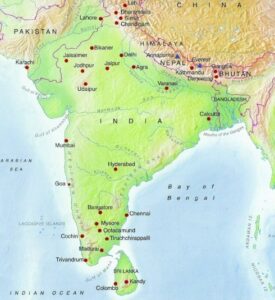Which are the physical geography of India that contribute significantly to its landscape and natural resources?
The carrying capacity of the environment refers to the maximum number of individuals or activities an environment can support without causing significant negative impacts. It includes factors like resource availability, habitat space, and the ability to absorb waste and regenerate. **Need forRead more
The carrying capacity of the environment refers to the maximum number of individuals or activities an environment can support without causing significant negative impacts. It includes factors like resource availability, habitat space, and the ability to absorb waste and regenerate.
**Need for Sustainable Tourism in India’s Hilly Areas:**
1. **Environmental Preservation**: Hilly areas like the Himalayas are ecologically sensitive. Sustainable tourism ensures that natural resources, such as forests, water bodies, and wildlife, are protected. Over-tourism can lead to deforestation, water pollution, and habitat destruction.
2. **Cultural Integrity**: Hilly regions often have unique cultures and traditions. Sustainable tourism respects and preserves local customs and heritage, preventing them from being overshadowed by mass tourism.
3. **Economic Benefits**: Sustainable tourism can provide long-term economic benefits to local communities. By promoting eco-friendly practices, locals can engage in tourism without depleting their natural resources, ensuring continued income.
4. **Quality of Life**: Limiting the number of tourists to match the carrying capacity reduces overcrowding and strain on local infrastructure. This improves the quality of life for residents and provides a better experience for visitors.
5. **Climate Change Mitigation**: Sustainable tourism practices, such as reducing carbon footprints and promoting eco-friendly transportation, help mitigate climate change impacts, which are particularly severe in hilly areas.
In conclusion, sustainable tourism is essential for protecting India’s hilly areas, ensuring that these regions can continue to thrive ecologically, culturally, and economically.
See less

India's diverse physical geography significantly shapes its landscape and natural resources. Here are the key physical features that contribute to this diversity: ### 1. The Himalayas **Significance:** - Forming the northern boundary, the Himalayas play a crucial role in shaping India'Read more
India’s diverse physical geography significantly shapes its landscape and natural resources. Here are the key physical features that contribute to this diversity:
### 1. The Himalayas
**Significance:**
– Forming the northern boundary, the Himalayas play a crucial role in shaping India’s climate by acting as a barrier to cold Central Asian winds.
– They are a source of major rivers like the Ganges, Yamuna, and Brahmaputra, which support agriculture and provide water resources.
**Natural Resources:**
– Rich in forests, medicinal plants, and minerals like limestone and gypsum.
– The region supports hydroelectric power projects due to its numerous rivers and high elevation.
### 2. The Indo-Gangetic Plain
**Significance:**
– Stretching from the Punjab region in the west to the Bengal delta in the east, this fertile plain is one of the most densely populated areas in the world.
– It is the agricultural heartland of India, producing wheat, rice, sugarcane, and other crops.
**Natural Resources:**
– Fertile alluvial soil supports intensive agriculture.
– Significant groundwater resources for irrigation and drinking purposes.
### 3. The Thar Desert
**Significance:**
– Located in the northwestern part of India, the Thar Desert influences the climate and lifestyle of the region.
– Despite its arid conditions, it supports unique flora and fauna adapted to desert life.
**Natural Resources:**
– Rich in minerals like gypsum, phosphorite, and limestone.
– Potential for solar and wind energy generation due to the high sunlight and wind availability.
### 4. The Peninsular Plateau
**Significance:**
– Covering most of central and southern India, this ancient landmass is known for its rich mineral deposits and diverse landscapes.
– Home to several important rivers like the Godavari, Krishna, and Kaveri, which are vital for irrigation and water supply.
**Natural Resources:**
– Abundant in minerals like iron ore, manganese, bauxite, and gold.
– Rich in forests, supporting biodiversity and providing timber and other forest products.
### 5. The Coastal Plains
**Significance:**
– India has a long coastline along the Arabian Sea to the west and the Bay of Bengal to the east.
– The coastal plains are important for agriculture, fishing, and trade.
**Natural Resources:**
– Fertile soil supports crops like rice, coconut, and cashew nuts.
– Rich marine resources support a thriving fishing industry.
– Coastal areas are also significant for tourism and trade, with major ports like Mumbai, Chennai, and Kolkata.
### 6. The Western and Eastern Ghats
**Significance:**
– These mountain ranges run parallel to the western and eastern coasts of India, respectively.
– They are important for their biodiversity, with several protected areas and wildlife sanctuaries.
**Natural Resources:**
– Rich in forests, supporting diverse flora and fauna.
– Important for plantation crops like tea, coffee, rubber, and spices.
– The Western Ghats are a key water source, with many rivers originating here.
### 7. The Islands
**Andaman and Nicobar Islands:**
– Located in the Bay of Bengal, these islands are known for their rich biodiversity and marine life.
– They hold strategic significance for India’s maritime boundaries and defense.
**Lakshadweep Islands:**
– Situated in the Arabian Sea, these coral islands are known for their unique ecosystems and tourism potential.
**Natural Resources:**
– Marine resources and fisheries.
– Potential for tourism and maritime activities.
### Conclusion
India’s physical geography, from the towering Himalayas to the fertile Indo-Gangetic Plain, the arid Thar Desert, and the rich Peninsular Plateau, plays a crucial role in shaping its natural resources and landscape. This diversity not only supports a wide range of ecosystems and biodiversity but also contributes significantly to agriculture, mining, energy production, and economic activities.
See less